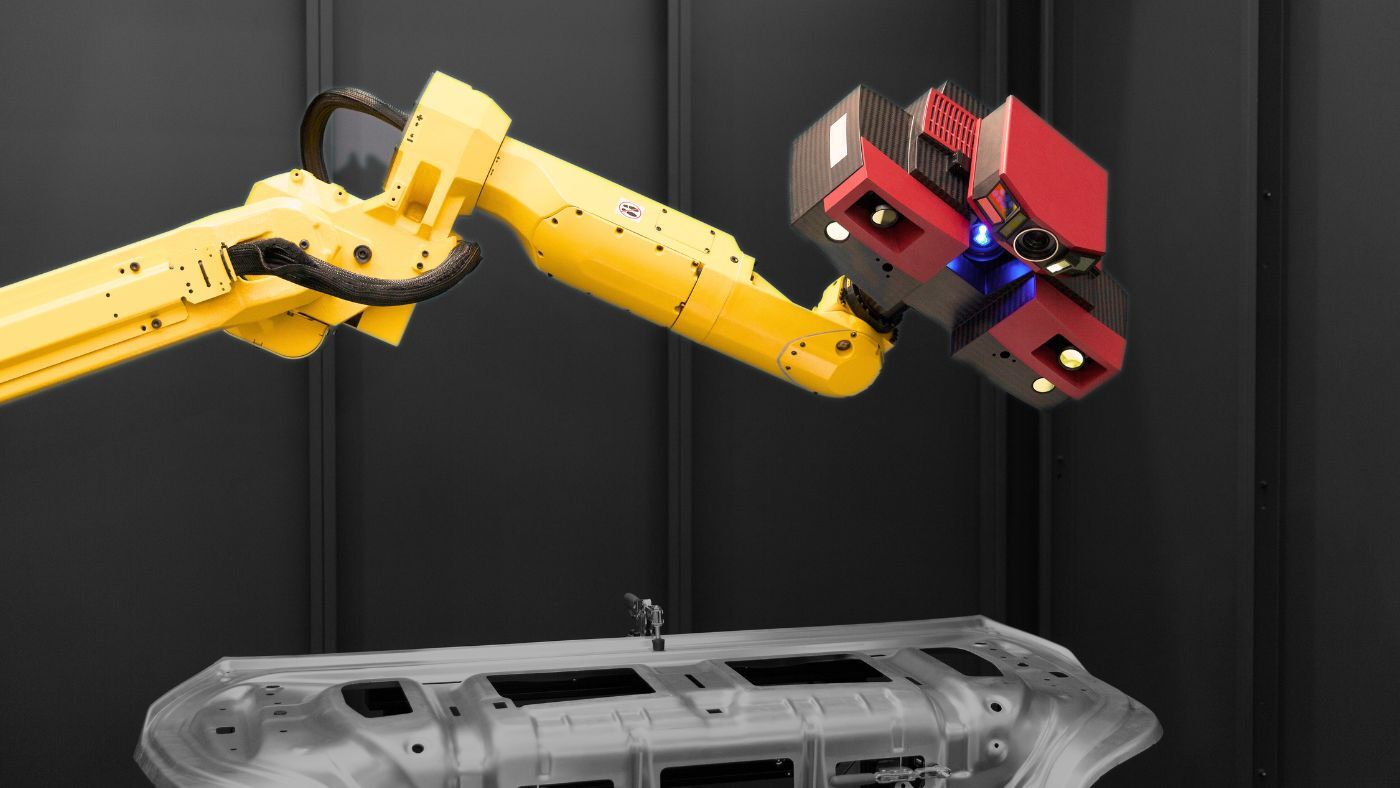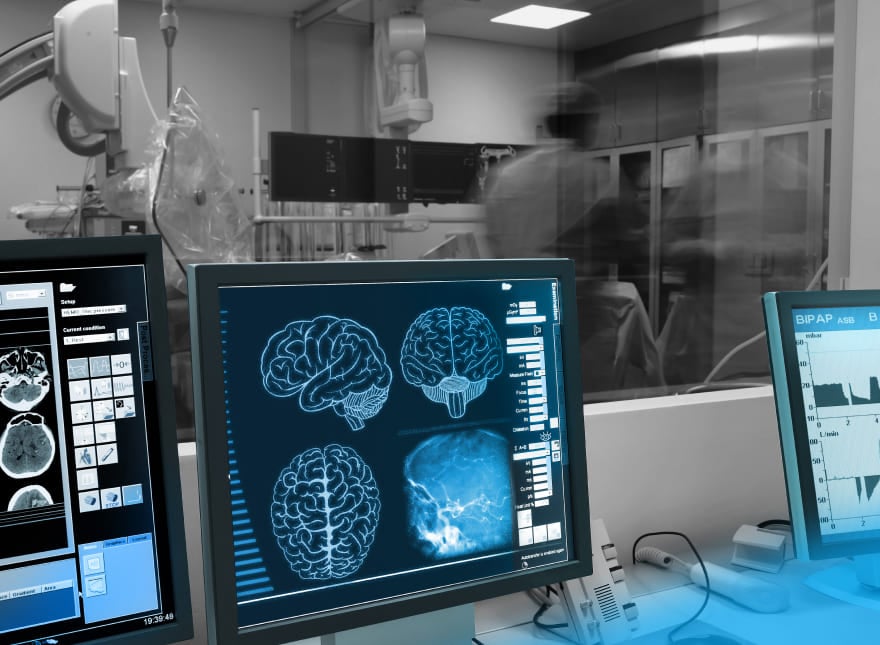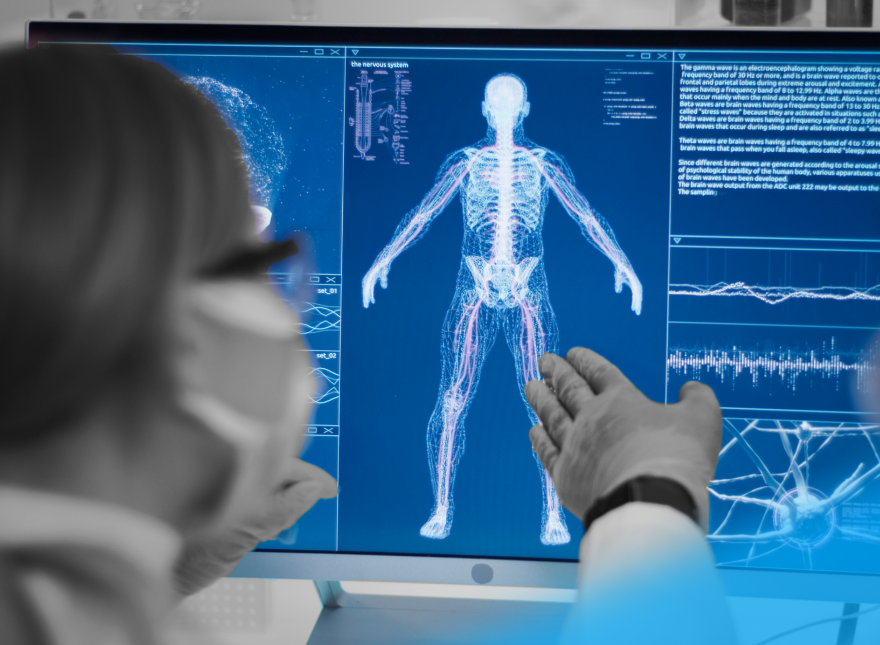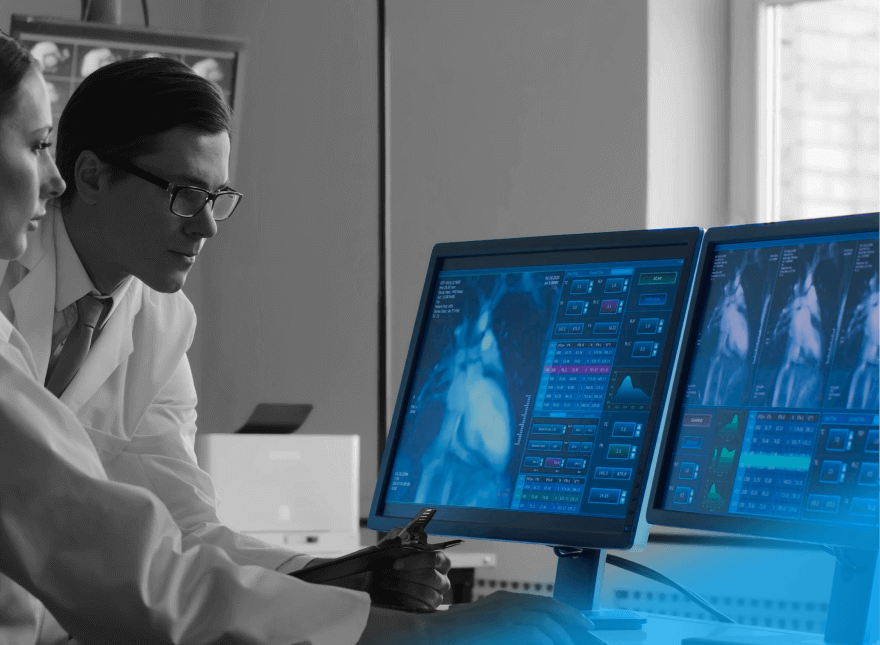Check out our latest blog article: From component to enterprise – modular robotics done right.
How Startups Use Artificial Intelligence in Surgery
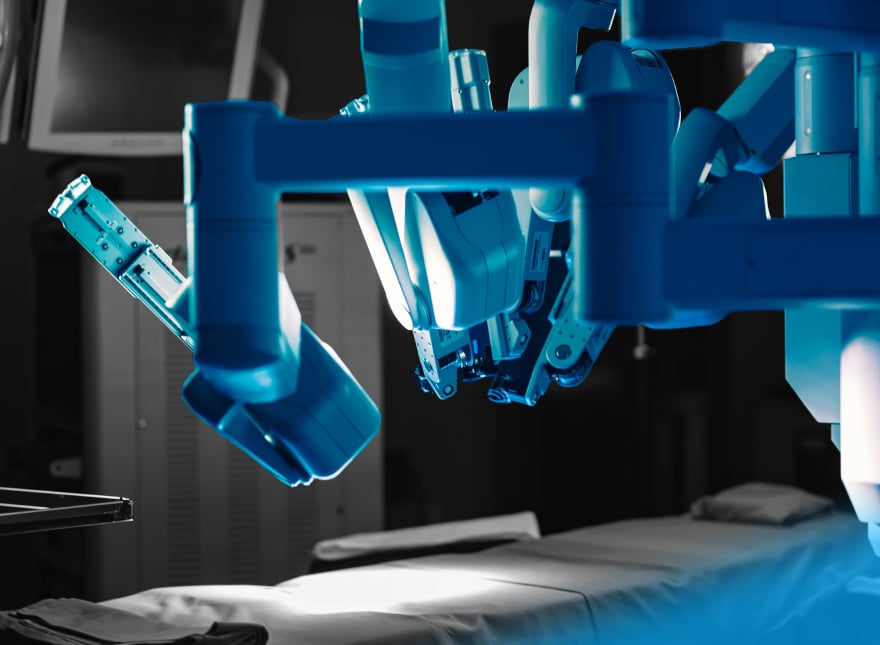
For two decades, da Vinci has been the most popular robotic surgical system in the world. It has been sold worldwide, including in the US, Europe, Canada, and Japan. The robot is immune from human error and conducts procedures in the operating room (OR) more precisely.
However, the precision of robotics is no longer enough in surgery. As the world’s population ages, patients’ health issues are getting more complex. To tackle them, a surgeon needs an assistant that will be autonomous, multi-functional, and easy to use. This is why more and more innovative startups are hitting the market with solutions that enable the use of artificial intelligence in surgery. Let’s take a closer look at the use of AI in surgery along with real-life examples.
How to Empower Robotics in Surgery Through Artificial Intelligence
Ten years ago, healthcare robots were mostly used to conduct more precise and less intrusive surgeries from a distance. The surgeon would be positioned behind a console. They would view magnified images on a screen and control robotic arms and tools with a haptic interface. These robots were accurate, but they required a lot of attention from the surgeon and too much space in the OR.
Focus is now turning to robots’ autonomy, flexibility, and ability to self-learn. Surgeons want robots to keep track of any change in the OR, detect errors, and react to emergencies. To achieve this, robots leverage advanced AI solutions which include the following types:
- Pattern-recognition solutions. A robot is trained with a set of surgical procedures. The machine learns a pattern, replicates it with advanced precision, and adjusts its actions in real time. For example, a robot is trained in tissue removal patterns. If it detects tissue deformations during the surgery, the robot makes alterations to its surgical plan.
- Deep Learning (DL) solutions. DL algorithms deepen a robot’s autonomy level in its training and include scenarios from pre- and post-operative stages. Let’s imagine that a robot is used for a surgery on a patient with chronic kidney disease. The robot goes through the pre-operative planning stage and detects abnormalities from CT scans. This allows the machine to predict the risks of kidney failure during the procedure. If it detects bleeding, it adjusts itself to save the patient’s life.
- Computer vision solutions. This technology detects patterns in images (3D images and scans) and video during surgery. For example, a robot is trained to recognize and classify suturing gestures. During surgery, it repeats them with greater accuracy.
Recent advances in AI are opening a wealth of opportunities in surgical robotics. Research centers and seed investment rounds know this and pour more money into the technology. In the coming years, the medical robot market is expected to increase exponentially.
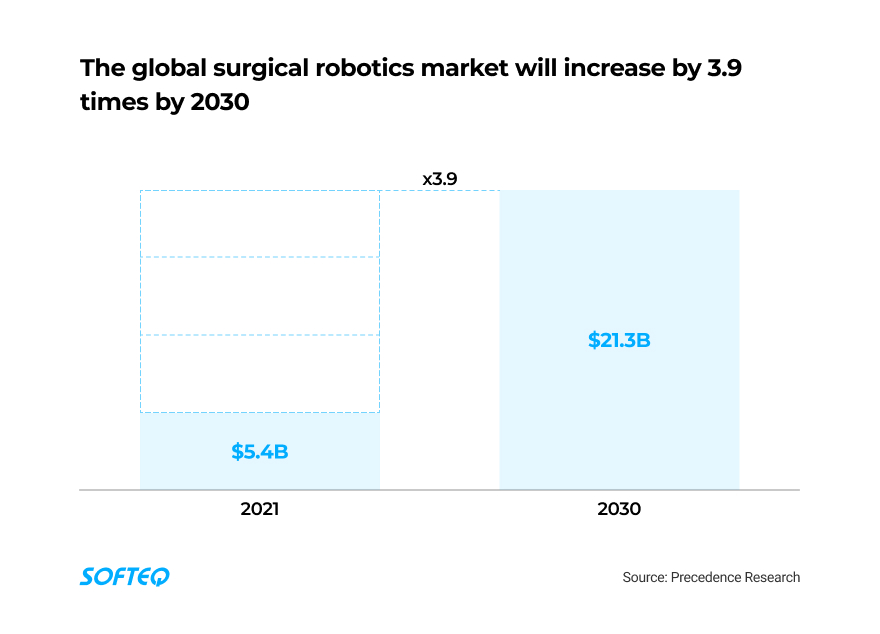
Now, let’s see how robot manufacturers are hitting the market today. Here are the three most promising ideas, with real-life examples.
Use Case 1: Multi-Purpose Platform
Traditional robotics solutions in surgery perform their tasks in isolation from other systems. They are barely integrated into other surgical care processes. This makes the pre-operative and intra-operative stages much harder. Here’s an example:
Before a surgeon can install an orthopedic implant, they need to create a patient-specific implant plan. To do this, they use a patient’s CT scans and data from other medical records. In clinics with traditional robotics systems, patients have to take care of CT scans themselves. Sometimes, they need to travel to a specialized medical center miles away from their hometown. Such trips can be very time- and money-consuming. When the surgeon receives the CT scans, they use them to create an implant placement plan and set up the robot. But here’s a problem: the robot doesn’t receive extra data from other sources, so it can’t adjust itself if something changes during the procedure, unless the surgeon reconfigures it.
AI in robotic surgery makes machines part of the OR and hospital ecosystem. They integrate with other systems and get access to patients’ records. A robot searches for, finds, and extracts information from these records independently. In some cases, the robot may discover that the data at hand is sufficient for the surgery. This means redundant additional examinations can be avoided. For patients, this technology translates to less spending and quicker surgical admission. For surgeons, this leads to more efficient procedures in the OR.
Real-Life Example: ROSA for Knee Surgery and Implants
ROSA (or Robotic Surgical Assistant) helps perform total knee arthroplasty (TKA) surgeries. The system was created by Zimmer Biomet and received its FDA clearance in 2019. The solution has brought many procedures to a new level by improving precision and refining the process. But here’s the most important innovation: the robotic system acts as a multi-purpose platform and integrates the pre-operative, intra-operative, and post-operative stages of knee surgery.
The solution is used as a standalone surgery robot and healthcare platform.
As a surgery robot, ROSA assists with knee replacement procedures. It functions in the following ways:
- Carries out pre-operative virtual planning
- Provides real-time intra-operative assessments
- Manages interrelated and changing variables during surgery
- Robotizes the positioning of cutting guides. This allows the surgeon to use the saw and keep control of the cutting device with more ease.
As a digital platform, the solution creates individual care plans.
- ZBEdge and OrthoIntel Orthopedic Intelligence analytics platforms help make the best decision during surgery.
- The platform applies AI algorithms during data analysis to refine surgical decisions.
- mymobility, a mobile version of the care management platform, collects patient data after the surgery and selects the best care plan.
With ROSA, surgeons understand each patient’s case in more detail. As a result, they are able to provide individual care.
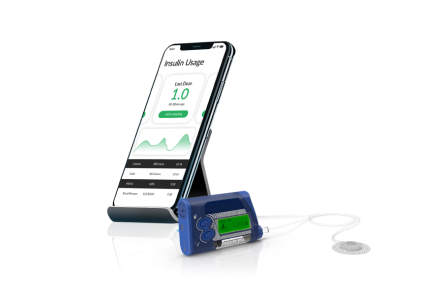
Use Case 2: Fitting into Existing Processes
The cost is not the only factor that stops hospital administrators from purchasing a robot. The machine significantly affects a healthcare institution’s processes and the lives of surgeons and medical staff.
First, traditional robots are bulky and require a lot of space. Sometimes, the robot’s operation and maintenance are so specific that the hospital has to rebuild their OR suite for the machine. This makes the purchase even more costly.
Second, some surgeons feel uncomfortable sitting behind a console while a robot takes their place by the operating table. They would prefer to conduct procedures themselves, despite appreciating the increased control and precision that robots provide. In some cases, surgeons even feel competition with the machines.
New robots that appear on the market don’t alter processes; they improve them. Thanks to AI in surgery, they are collaborative and adaptive, and they improve medical work without disrupting it. Such robots don’t put surgeons behind the console; they help them by the operating table.
Real-Life Example: Maestro
Moon Surgical, a Franco-American team, has set a great example of collaborative robots with Maestro. In June 2022, Moon Surgical raised $31.3 million in series A funding with their project.
Maestro serves as an extra set of arms to assist the surgeon, not replace them. Its aim is to ensure full control over the instruments for a surgeon conducting a procedure. The robot doesn't affect the workflow. It’s also much smaller than a huge da Vinci system, so it fits effortlessly into any OR.
The solution’s strengths include the following:
- AI and ML algorithms developed in cooperation with King’s College London. This makes the solution 100% reliable, and surgeons don’t have to worry about workflow interruptions. The Maestro is pre-trained and fits perfectly into any procedure.
- No need to build large surgical suites around robotic systems. The company sees their product as efficient, but no more critical than other elements of the OR. Essentially, it can be placed between the lap tower and the anesthesiology cart.
- Full control intra-operatively. The surgeon remains at the center of the procedure and controls the operating theater. The robot ensures that everything stays within arm’s reach—there are just two more arms.
- Ability to scale up. The company’s initial target is general surgery and, more specifically, laparoscopy. However, it can be adapted to different types of operations.
Use Case 3: Fully Autonomous Solution
Precision is one of the strongest selling points of the medical robots market. However, today’s robots are expected to be not just precise, but autonomous too. The healthcare industry wants robots to be able to learn and make quick alterations if the situation demands it.
Imagine a surgeon using a robot for, let’s say, bone preparation in a joint replacement surgery. Problems with soft tissue balance emerge unexpectedly during the procedure. With older models of surgical robots, the surgeon would have to act impromptu, by aligning the components manually or reconfiguring the robot. That would add stress and increase the risk of implant failure.
AI in robotic surgery helps a new-generation robot make quick alterations itself in real time. When something goes wrong, the robot changes its surgical plan and provides an alternative solution.
Real-Life Example: Smart Tissue Autonomous Robot (STAR)
The Smart Tissue Autonomous Robot (STAR) gets a leg up on the competition in terms of its autonomy. The system is used in laparoscopic operations to create and execute a surgical plan with minimal human intervention.
Thanks to AI algorithms, STAR quickly adapts if an issue arises during surgery by using:
- ML-based tracking algorithms
- 3D imaging system
- Computer vision
- Advanced control techniques
Here’s how it works. STAR has been trained on more than 9,000 motion profiles to predict tissue motion and guide the surgeon’s plans. During the operation, the robot synchronizes with a camera. It scans and creates suture plans while the tissue is stationary. Using computer vision and ML algorithms, STAR generates two plans. Once the surgeon has selected the most suitable one, the robot applies it to the tissue and reimages the area for tissue deformation. If tissue has changed position too significantly, the robot notifies the surgeon. They can initiate a new plan, and STAR will make necessary amendments. This process can be repeated multiple times during the procedure.
So far, STAR has been tested in animal surgeries. It has shown much better results than humans performing the same procedure. The manufacturers boast that it’s the first robot to plan, adapt, and execute a surgical plan with minimal intervention from a human surgeon.
Why the Arrival of AI in Surgery Is Unavoidable
What could be the reasons for such changes in surgery robotics? The surgery industry is facing new challenges, which creates demand for a new kind of robot. The world’s population is aging, and demand for healthcare professionals is becoming more pressing. To be efficient, doctors need smarter robotic assistance. This encourages startups to create new solutions even for the most complex procedures. All in all, this brings about the following trends:
- High interest from hospitals. The way robots eliminate error and optimize surgeries is their strongest selling point. But now hospitals expect more than that. Solutions need to be ergonomic, autonomous, and affordable. This is exactly what AI in robotics surgery provides.
- Demand from surgeons. Some surgeons are reluctant to use robots. Some don’t trust machines, while others are worried that robots will lock them out of their operating room and replace them. But analysts say that when robotic penetration reaches 35%, surgeons will see them as part of their routine and even demand access to the technology. Some areas are close to reaching this level of usage. Let’s take joint arthroplasty as an example: 33% of the American Association of Hip and Knee Surgeons (AAHKS) have gotten used to robotic assistants.
- Approval from patients. Patients tend to trust robots. Among those who have undergone robot-assisted surgery, 99% are pleased with the overall care. 91% would recommend robot-assisted surgery.
But there are also serious challenges in the AI robotics surgery market, such as:
- Financial challenges. Some healthcare systems, hospitals, and ambulatory service centers (ASCs) face serious budget restrictions. This makes it hard to buy an asset that is as high-value as a robot. Therefore, manufacturers have to provide other schemes besides a straight purchase, including a fair market value purchase option, an outright purchase at the end of the term, or lease renewal.
- Supply chain disruptions. If you’re planning to build a surgical robot, get ready for supply challenges. During the pandemic, most manufacturers couldn’t get components on time. This delayed product delivery and led to a drop in sales. Logistics is now recovering, but robot manufacturers are still feeling the aftermath.
- Long and costly FDA procedures. Even if your device is ready to hit the market or has already been released in other countries, the US bureaucracy and certification process remains a constraint. Getting FDA approval takes years, has high costs, and doesn’t always lead to a successful result. In the US, the government has set very strict certification criteria that prevent medical innovations from reaching the market too quickly. Take the case of Medtronik. It’s an American enterprise whose surgical robot, Hugo, is used in Latin America, Europe, Canada, and Japan. Yet, for many years, they haven’t been able to get a green light from the FDA to start operating in their native American market.
However, obstacles don’t discourage large holdings (like Siemens and Johnsons & Johnsons) and innovative startups. The niche is transforming radically and feels like a gold mine. The positive trends mentioned above even out the playing field. Now, new entrants can compete on equal terms with their well-established competitors.
Summing Up
The medical robotics market is undergoing a dramatic change. Ten years ago, it was cornered by large companies, but hospitals no longer want to invest in massive and expensive models that solve a single task and disrupt processes. They need autonomous, flexible, and multi-functional robotic solutions. And that’s exactly what AI stands for.
If entering the surgical robotics niche is on your mind, we’ll provide expert help with AI in surgery. Softeq has already delivered a variety of complex FDA- and HIPAA-certified projects. Contact us and let us know how we can help.
More articles on the topic
